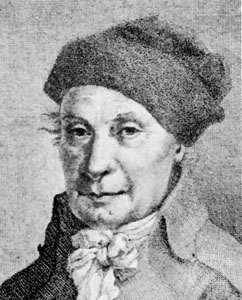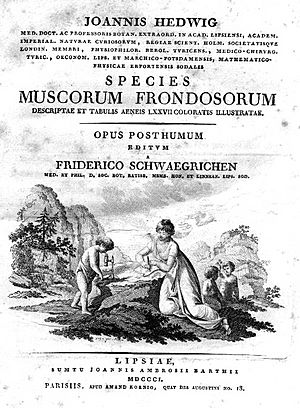Johann Hedwig facts for kids
Quick facts for kids
Johann Hedwig
|
|
|---|---|

Johann Hedwig, 1793
|
|
| Born | 8 December 1730 Principality of Transylvania
|
| Died | 18 February 1799 (aged 68) |
| Nationality | German |
| Alma mater | University of Leipzig |
| Known for | Bryology |
| Scientific career | |
| Fields | Botany |
| Author abbrev. (botany) | Hedw. |
Johann Hedwig (born December 8, 1730, died February 18, 1799) was a German scientist who loved studying mosses. He is often called the "father of bryology", which is the study of mosses and similar plants. Hedwig was famous for carefully watching how these plants reproduce. Many of his notes were written in Latin.
Contents
Early Life and Education
Johann Hedwig was born in Brașov, Transylvania, on December 8, 1730. His father was a shoemaker, so Johann grew up without much money. Even as a child, he was fascinated by mosses. He later went to the University of Leipzig to study medicine. He earned his medical degree in 1759.
A Doctor's Hobby: Studying Plants
After finishing his studies, Hedwig worked as a doctor for 20 years. He couldn't get a license to practice medicine in Transylvania with his Leipzig degree. So, he became a general doctor in Chemnitz. During this time, he started studying botany as a hobby.
He would collect plant samples every morning before work. Then, in the evenings, he would study what he had found. A kind person named Johann Christian Daniel von Schreber gave him a microscope and a small library. This helped Hedwig a lot with his studies.
Amazing Discoveries About Mosses
Hedwig was very good at using his microscope. He was also skilled at drawing what he saw. He was able to find and draw the tiny parts of mosses that help them reproduce. These parts are called antheridia and archegonia. He even saw the male cells (gametes) of mosses.
He watched how moss spores grew into new plants. He saw them form a special thread-like structure called a protonema. Hedwig also made useful observations about types of algae like Chara and Spirogyra. He showed that he wasn't the first to grow new mosses from spores. Another scientist, David Meese, had done it before him.
Moving to Leipzig and Becoming a Professor
In 1781, Hedwig moved to Leipzig. He worked as a doctor at the city hospital there. In 1782, he published his first big book. It was called Fundamentum historiae naturalis muscorum frondosorum.
Things changed for Hedwig in 1786. He was hired as a professor of medicine at the University of Leipzig. In 1789, he became a professor of botany. He also became the director of the university's botanical garden. He was invited to join important scientific groups. In 1788, he became a Fellow of the Royal Society. In 1790, he joined the Royal Swedish Academy of Sciences. In 1792, he became a member of the Academy of Sciences Leopoldina.
His most important work was a book called Species muscorum frondosorum. It was published in 1801, after he had passed away. This book described almost all the moss species known at that time. It became the starting point for how mosses are named today.
Johann Hedwig's Legacy
Johann Hedwig's son, Romanus Adolf Hedwig, also became a botanist.
Today, Johann Hedwig is remembered in several ways:
- A type of moss is named after him: Hedwigia.
- A scientific journal for plant studies is called Nova Hedwigia.
- The International Association of Bryologists gives out the Hedwig Medal. This award honors scientists who have made amazing contributions to the study of mosses.
Hedwig's personal collection of dried plants, called a herbarium, was sold in 1810. Most of it was bought by the Botanical Garden of Geneva. His collection is still kept there today.



